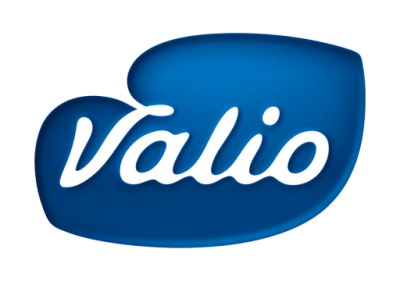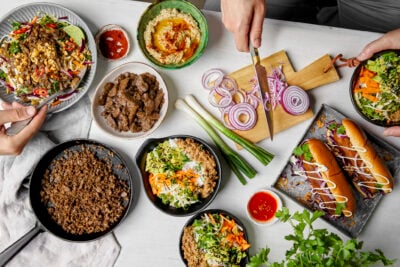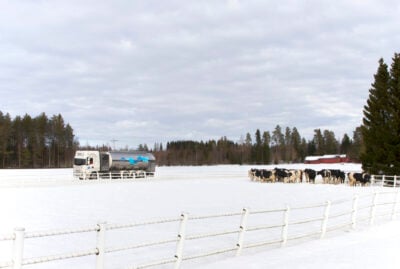The record warm summer sparked a discussion about climate change and the future of food production in Finland and Europe. The environmental impacts of meat and milk production are at the core of the discussion because ruminating cows create methane, a greenhouse gas. The current means to reduce methane have been exhausted so we need new climate actions. Farmers in the future may become solvers of climate change, if fields can be turned into better carbon sinks. Better grass harvests mean also better profitability for dairy farms. As a responsible food company, Valio aims for a carbon-neutral milk chain.
For decades, Valio Group has done tremendous work to reduce the environmental impacts of methane emissions from ruminants and eutrophication caused by phosphorus and nitrogen fertilizers, and has worked to increase resource efficiency in the production of one kilo of meat and milk. For example, the amount of methane has been cut in half over fifty years as a result of dairy farms’ good efforts and animal breeding: cow health and nutrition has improved, and when a cow produces more milk, also the emissions per milk liter are reduced.
Fields and soil as carbon sinks
Indeed, a lot has already been accomplished, but the methods currently being used to reduce methane emissions have been exhausted. The milk chain’s share of Finland’s greenhouse gas emissions has remained at about 3-4 percent throughout the 2000s. So what can we do next?
“Merely reducing emissions is not enough if we want to achieve the Paris climate agreement target to limit global warming to two degrees Celsius. We must also be able to remove emissions from the atmosphere. The importance of forests as carbon sinks has long been known. Now it is time to start setting our sights on soil. Fields may become significant carbon sinks in the future,” says Juha Nousiainen, Director of Farm Services at Valio.
Healthy soil can absorb and store atmospheric carbon. Additionally, it efficiently retains nutrients so that nitrogen and phosphorus, e.g., do not runoff into waterways. That is why cattle farming combined with the right kind of field crops and the circular economy can be a solution to climate change mitigation. A carbon-neutral milk chain means that the production chain is able to absorb more carbon than it releases into the atmosphere.
“Healthy soil absorbs twice as much atmospheric carbon than plants do. The soil’s organic matter, for example plant debris and microbes, plays a critical role in storage. Factors such as crop rotation that is too limited, tillage intensity and unilateral use of artificial fertilizers may weaken soil condition. Farmers can improve carbon absorption with, e.g., crop rotation, by increasing the spectrum of grass species, and by keeping the fields green for as much of the year as possible, practices that are already being applied at many farms,” Juha continues.
Savings and profitability for farms
If realized, a carbon-neutral milk chain brings savings and cost-efficiency for the producer and improves the profitability of all Finnish agriculture.
“I have talked with many Valio dairy farm entrepreneurs, and I know that a big number of farmers are very eager to solve environmental problems. We at Valio have received requests to engage in more collaboration, e.g., to preserve biodiversity. We will be working with the cooperatives to offer new kinds of information and support for the environmental work of farms: best practices on carbon absorption into soil, increasing biodiversity, reducing the methane emissions of cows, and putting manure back into the nutrient cycle. Many of the methods are simple and don’t generate any extra costs for the farms. On the contrary, diverse and healthy fields also improve crops and can be one way to improve the profitability of farms,” Juha reflects.
It is still too early to stay when a carbon-neutral milk chain will be achieved. The goal is within the next few decades.
“We are starting with a few dozen voluntary farms. There are already enthusiastic pilot farms that can be found for the cultivated grass groups, for example. We believe that in the upcoming years there might be hundreds of voluntary dairy farms participating in the climate work.”
More than 90% of the environmental impact, or carbon footprint, of a dairy product is created in primary production – in other words, before the milk truck drives through the gates of the dairy. That is why the work to be done at farms plays such a big role in achieving the carbon-neutral milk chain. There is also a lot to do in the later phases of the milk chain: improving the energy efficiency of production plants, optimizing transportation routes, reducing the carbon footprint of packaging, and reducing wastage at the plants are examples of concrete actions Valio has already taken.
Collaboration with research groups and environmental organizations
New research data is also needed to achieve a carbon-neutral milk chain.
“There has been little research on the emissions of agricultural countries and their ability to remove emissions from the atmosphere. We are collaborating with leading research groups and environmental organizations, exploring solutions for soil and grass carbon sinks in particular. The research data provides us with new tools also for farms,” says Valio’s Anu Kaukovirta-Norja, Senior Vice President, Research and Technology.
Valio is creating currently the so-called ProLanta (“ProManure”) ecosystem and has invited various players to join in.
“We want to efficiently capture the nitrogen and phosphorus contained in manure and return it to the nutrient cycle. Valio has developed a technology that can separate phosphorus and nitrogen from the manure into fertilizer fractions. At the same time, clean water and biogas, which can replace fossil fuels, are created. The manure from the Valio Group’s 5,300 farms would create enough biogas for use by all the farm equipment as well as Valio’s collection and delivery trucks. And there would even be some left for the plants to use,” Anu adds.
A major step for Finnish agriculture?
Nobel Laureate A.I. Virtanen headed Valio’s laboratory for close to 50 years. Under his leadership, Finnish agriculture overall made a major advancement with the introduction of AIV fodder to preserve feed for cows over the winter without compromising quality. Prior to that, cows didn’t really produce milk during winter − the feed was of such poor quality. Today’s agriculture likely wouldn’t exist in Finland without A.I. Virtanen’s innovations and Valio’s persistent work to implement them into practical use.
Now it is time to take what may be an equally big step forward. Good practices can spread also across Finnish borders, just as AIV fodder did.




